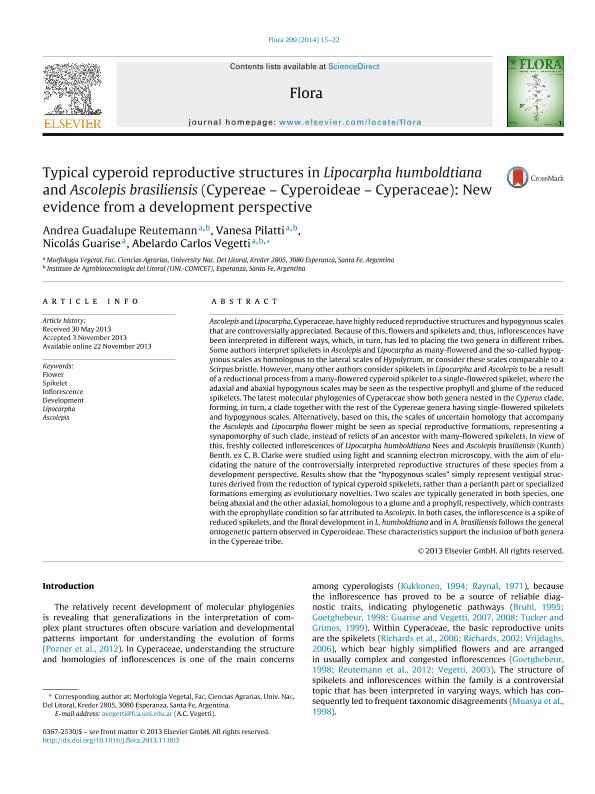Artículo
Typical cyperoid reproductive structures in Lipocarpha humboldtiana and Ascolepis brasiliensis (Cypereae-Cyperoideae-Cyperaceae): new evidence from a development perspective
Reutemann Arnolfo, Andrea Guadalupe ; Pilatti, Vanesa
; Pilatti, Vanesa ; Guarise, Nicolas Javier
; Guarise, Nicolas Javier ; Vegetti, Abelardo Carlos
; Vegetti, Abelardo Carlos
 ; Pilatti, Vanesa
; Pilatti, Vanesa ; Guarise, Nicolas Javier
; Guarise, Nicolas Javier ; Vegetti, Abelardo Carlos
; Vegetti, Abelardo Carlos
Fecha de publicación:
2014
Editorial:
Elsevier
Revista:
Flora
ISSN:
0367-2530
Idioma:
Inglés
Tipo de recurso:
Artículo publicado
Clasificación temática:
Resumen
Ascolepis and Lipocarpha, Cyperaceae, have highly reduced reproductive structures and hypogynous scales that are controversially appreciated. Because of this, flowers and spikelets and, thus, inflorescences have been interpreted in different ways, which, in turn, has led to placing the two genera in different tribes. Some authors interpret spikelets in Ascolepis and Lipocarpha as many-flowered and the so-called hypogynous scales as homologous to the lateral scales of Hypolytrum, or consider these scales comparable to a Scirpus bristle. However, many other authors consider spikelets in Lipocarpha and Ascolepis to be a result of a reductional process from a many-flowered cyperoid spikelet to a single-flowered spikelet, where the adaxial and abaxial hypogynous scales may be seen as the respective prophyll and glume of the reduced spikelets. The latest molecular phylogenies of Cyperaceae show both genera nested in the Cyperus clade, forming, in turn, a clade together with the rest of the Cypereae genera having single-flowered spikelets and hypogynous scales. Alternatively, based on this, the scales of uncertain homology that accompany the Ascolepis and Lipocarpha flower might be seen as special reproductive formations, representing a synapomorphy of such clade, instead of relicts of an ancestor with many-flowered spikelets. In view of this, freshly collected inflorescences of Lipocarpha humboldtiana Nees and Ascolepis brasiliensis (Kunth)Benth. ex C. B. Clarke were studied using light and scanning electron microscopy, with the aim of elucidating the nature of the controversially interpreted reproductive structures of these species from a development perspective. Results show that the ?hypogynous scales? simply represent vestigial structures derived from the reduction of typical cyperoid spikelets, rather than a perianth part or specialized formations emerging as evolutionary novelties. Two scales are typically generated in both species, one being abaxial and the other adaxial, homologous to a glume and a prophyll, respectively, which contrasts with the eprophyllate condition so far attributed to Ascolepis. In both cases, the inflorescence is a spike of reduced spikelets, and the floral development in L. humboldtiana and in A. brasiliensis follows the general ontogenetic pattern observed in Cyperoideae. These characteristics support the inclusion of both genera in the Cypereae tribe.
Palabras clave:
Flower
,
Spikelet
,
Inflorescence
,
Development
,
Lipocarpha
,
Ascolepis
,
Cypereae
,
Cyperoideae
Archivos asociados
Licencia
Identificadores
Colecciones
Articulos(IAL)
Articulos de INSTITUTO DE AGROBIOTECNOLOGIA DEL LITORAL
Articulos de INSTITUTO DE AGROBIOTECNOLOGIA DEL LITORAL
Citación
Reutemann Arnolfo, Andrea Guadalupe; Pilatti, Vanesa; Guarise, Nicolas Javier; Vegetti, Abelardo Carlos; Typical cyperoid reproductive structures in Lipocarpha humboldtiana and Ascolepis brasiliensis (Cypereae-Cyperoideae-Cyperaceae): new evidence from a development perspective; Elsevier; Flora; 209; 1; -1-2014; 15-22
Compartir
Altmétricas



